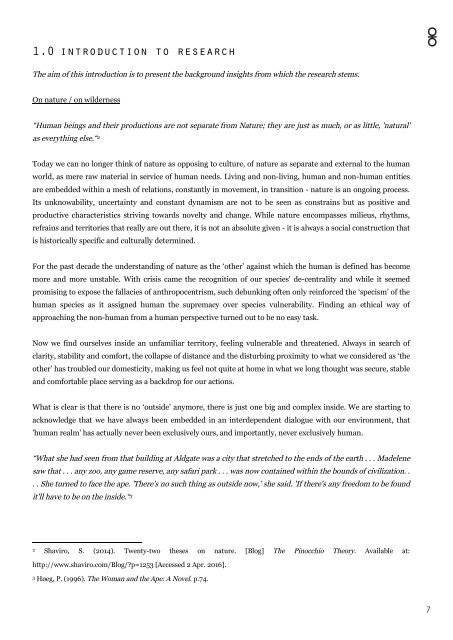Unfamiliar Territory_Research
You also want an ePaper? Increase the reach of your titles
YUMPU automatically turns print PDFs into web optimized ePapers that Google loves.
1.0 introduction to research<br />
⚮<br />
The aim of this introduction is to present the background insights from which the research stems.<br />
On nature / on wilderness<br />
“Human beings and their productions are not separate from Nature; they are just as much, or as little, 'natural'<br />
as everything else.“ 2<br />
Today we can no longer think of nature as opposing to culture, of nature as separate and external to the human<br />
world, as mere raw material in service of human needs. Living and non-living, human and non-human entities<br />
are embedded within a mesh of relations, constantly in movement, in transition - nature is an ongoing process.<br />
Its unknowability, uncertainty and constant dynamism are not to be seen as constrains but as positive and<br />
productive characteristics striving towards novelty and change. While nature encompasses milieus, rhythms,<br />
refrains and territories that really are out there, it is not an absolute given - it is always a social construction that<br />
is historically specific and culturally determined.<br />
For the past decade the understanding of nature as the ‘other’ against which the human is defined has become<br />
more and more unstable. With crisis came the recognition of our species' de-centrality and while it seemed<br />
promising to expose the fallacies of anthropocentrism, such debunking often only reinforced the ‘specism’ of the<br />
human species as it assigned human the supremacy over species vulnerability. Finding an ethical way of<br />
approaching the non-human from a human perspective turned out to be no easy task.<br />
Now we find ourselves inside an unfamiliar territory, feeling vulnerable and threatened. Always in search of<br />
clarity, stability and comfort, the collapse of distance and the disturbing proximity to what we considered as ‘the<br />
other’ has troubled our domesticity, making us feel not quite at home in what we long thought was secure, stable<br />
and comfortable place serving as a backdrop for our actions.<br />
What is clear is that there is no ‘outside’ anymore, there is just one big and complex inside. We are starting to<br />
acknowledge that we have always been embedded in an interdependent dialogue with our environment, that<br />
'human realm' has actually never been exclusively ours, and importantly, never exclusively human.<br />
“What she had seen from that building at Aldgate was a city that stretched to the ends of the earth . . . Madelene<br />
saw that . . . any zoo, any game reserve, any safari park . . . was now contained within the bounds of civilization. .<br />
. . She turned to face the ape. 'There's no such thing as outside now,' she said. 'If there's any freedom to be found<br />
it'll have to be on the inside.“ 3<br />
2 Shaviro, S. (2014). Twenty-two theses on nature. [Blog] The Pinocchio Theory. Available at:<br />
http://www.shaviro.com/Blog/?p=1253 [Accessed 2 Apr. 2016].<br />
3<br />
Høeg, P. (1996). The Woman and the Ape: A Novel. p.74.<br />
7


